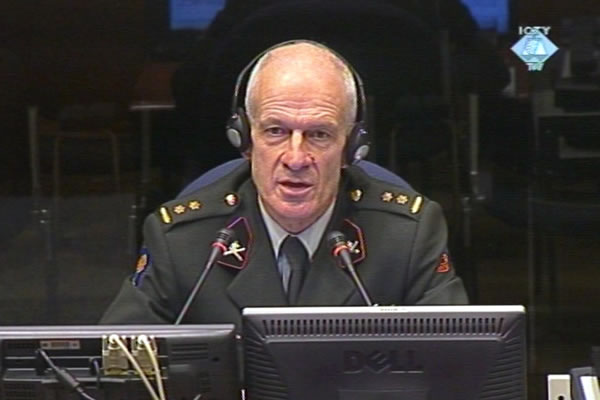Home
BEST OR WORST TACTICS USED IN KNIN ATTACK?
The defense has tried to challenge the argument put forward by Dutch lieutenant-colonel Konings that General Ante Gotovina’s decision to launch an artillery attack on Knin in August 1995 was ‘perhaps the worst possible tactics’ because of substantial risk to civilians. Defense counsel Kehoe noted that the danger to the Knin residents would have been even greater if the infantry had entered town without a previous ‘artillery preparation’
 Harry Konings, svjedok na suđenju Gotovini, Čermaku i Markaču
Harry Konings, svjedok na suđenju Gotovini, Čermaku i Markaču On the third day of the cross-examination of military expert Harry Konings American lawyer Greg Kehoe tried to prove that when Ante Gotovina decided on the tactics for the attack on Knin and other towns in Krajina, he opted for the tactics likely to cause least danger to the Serb civilians. General Gotovina was in command of the Croatian military forces in Operation Storm. Together with Ivan Cermak and Mladen Markac he is on trial for crimes committed against Serb civilians and their property during and after that operation.
In his report on the artillery attack against Knin drafted at the behest of the prosecution, Dutch lieutenant-colonel Konings noted that the Croatian Army should not have shelled the town because of the danger to civilians. The Croatian troops should have entered Knin without the artillery preparation because its infantry was stronger. The defense counsel put it to the witness that had the infantry entered town, civilian casualties would have been far greater due to street fighting which would have ensued. Furthermore, the fiercest artillery attack on Knin was launched in the early morning hours of 4 August 1995 when there were ‘fewest civilians out in the streets’.
The witness agreed in part with the defense argument in theory, adding that the shelling lasted more than 24 hours. It was unclear to him why Gotovina in his order of 2 August 1995 asked his subordinate commanders to ‘open artillery fire on Knin’ without identifying clearly the military targets in the town. Konings remained adamant that if the Croatian infantry had entered Knin without artillery support would have been riskier for the Croatian troops, but it would have caused less danger to the civilians in the town.
In his expert report based on the information he was given by the prosecution, Konings concluded that most military targets in Knin were of ‘little value’. Also, they were located in immediate vicinity of civilian buildings and therefore should not have been shelled. The defense argues that the attack on facilities such as barracks, railway junctions, the post office and the VSK Main Staff brought substantial advantage to the Croatian side because it obstructed communications and command of the enemy troops. The witness agreed with this claim only as far as the attack on the Main Staff was concerned. He once again repeated the conclusion of his expert report that the importance of the target and the risk for civilians in town had to be ‘proportionate’.
Harry Konings is expected to complete his evidence tomorrow.
Linked Reports
- Case : Gotovina et al. - "Operation Storm"
- 2009-01-16 PANIC AMONG SOLDIERS OR CIVILIANS?
- 2009-01-15 AMERICAN LAWS FOR GOTOVINA'S DEFENSE
- 2009-01-14 WITNESS: 'KNIN WAS LIKE SARAJEVO'
- 2009-01-20 GENERAL GOTOVINA ISSUED ‘VAGUE’ ORDER
- 2009-01-22 DANISH OBSERVER: OBJECTIVE OF OPERATION STORM WAS KRAJINA WITHOUT SERBS
- 2009-01-23 'IT IS ONLY HUMAN TO HATE ENEMY’
